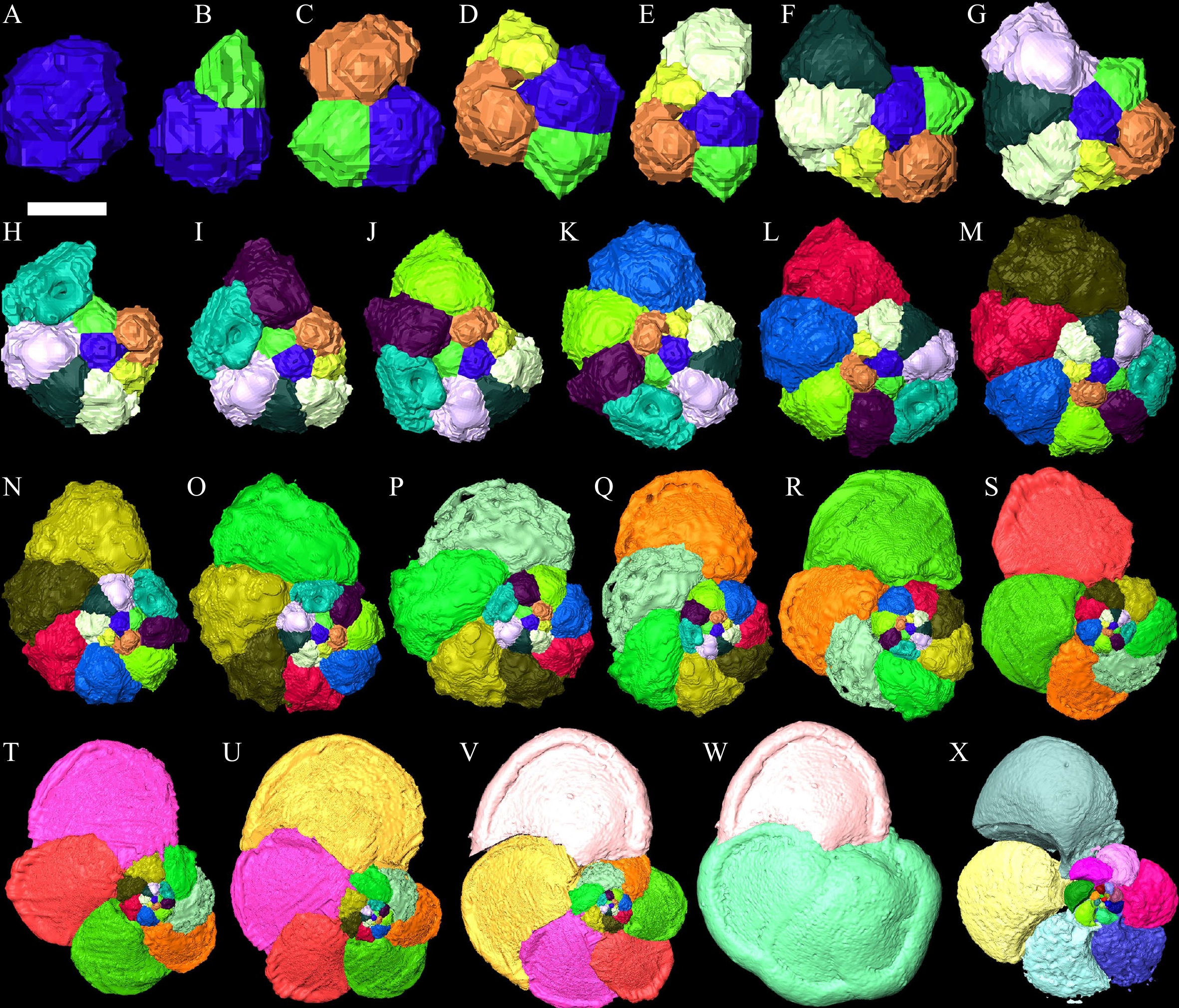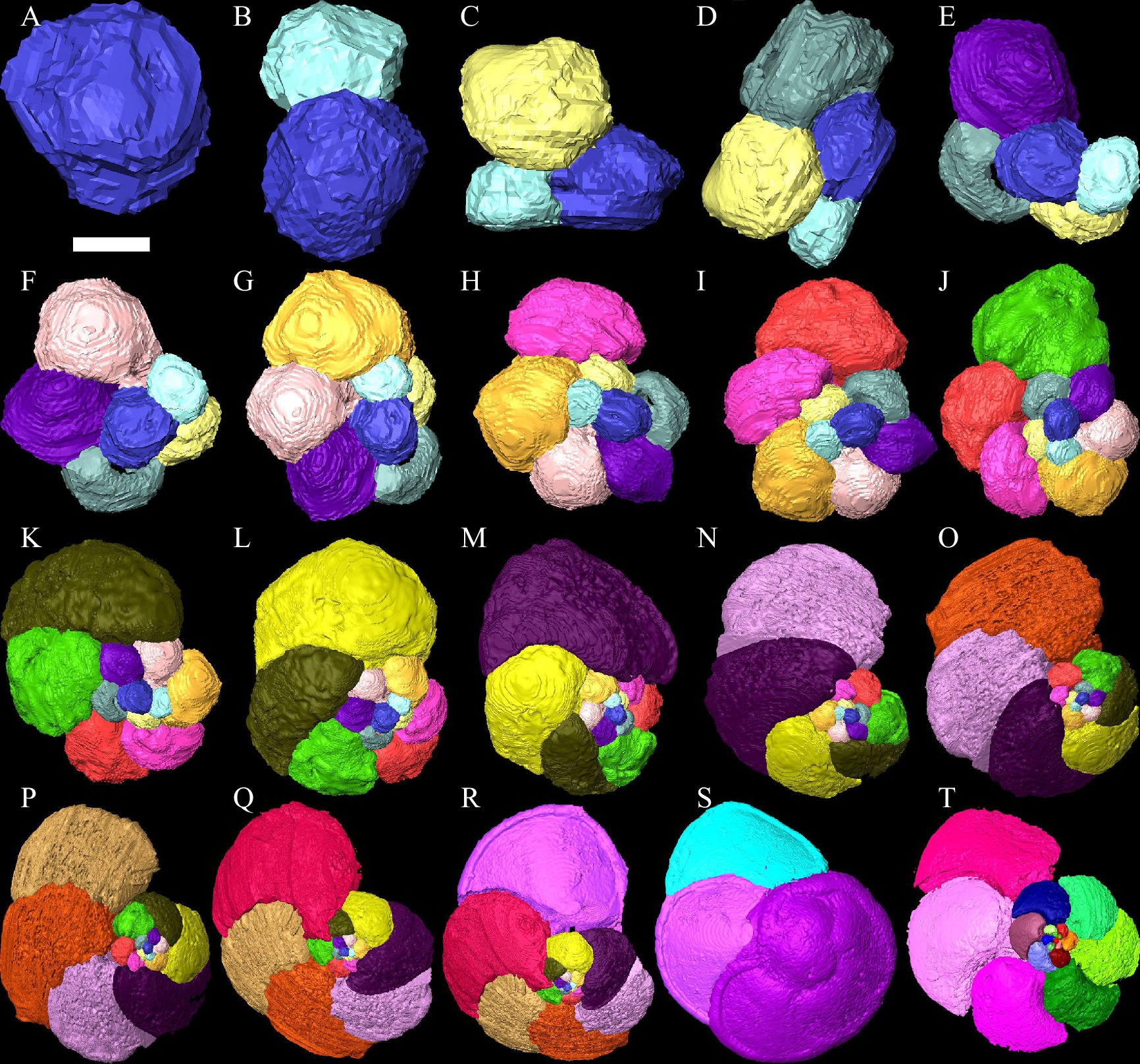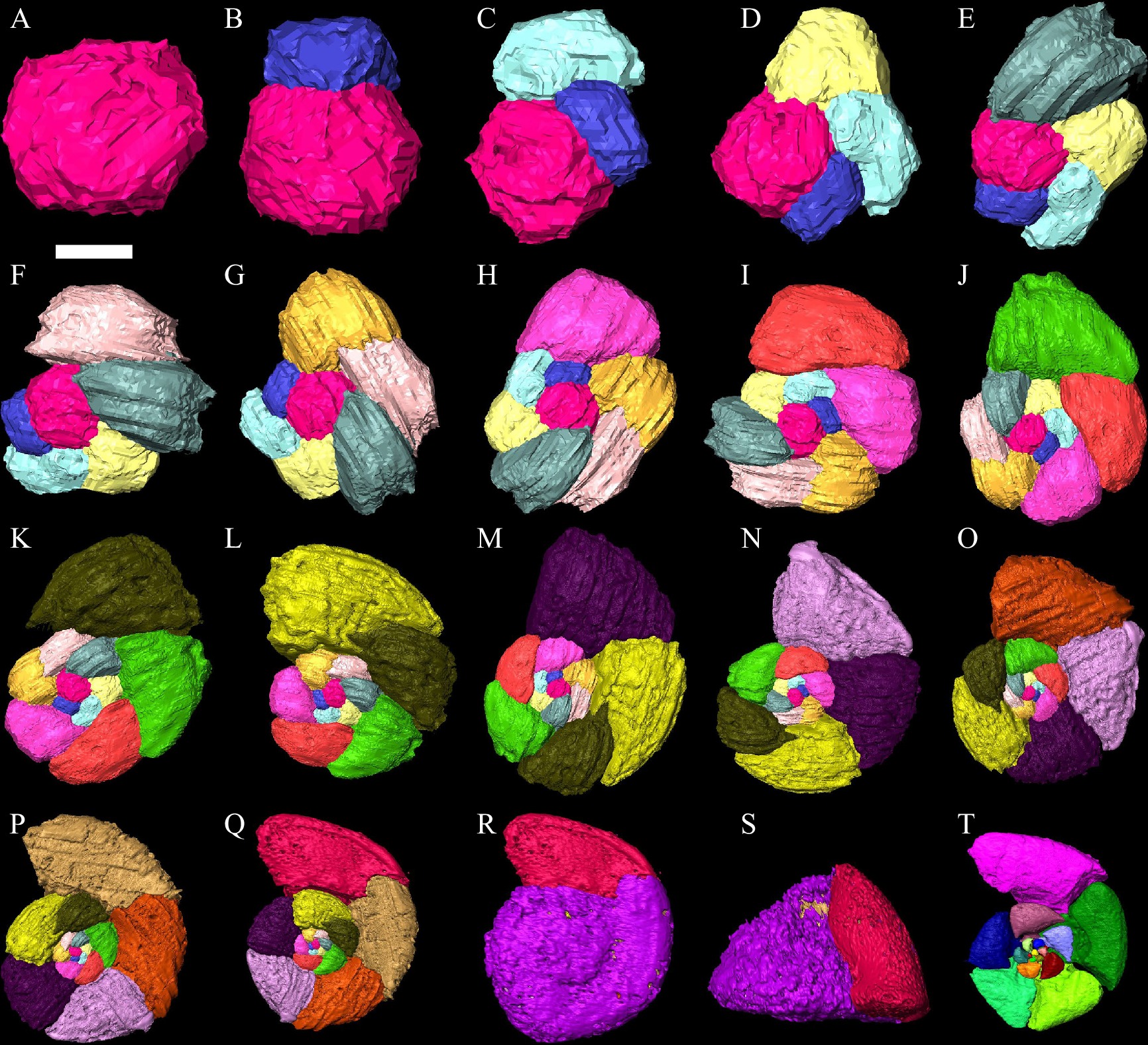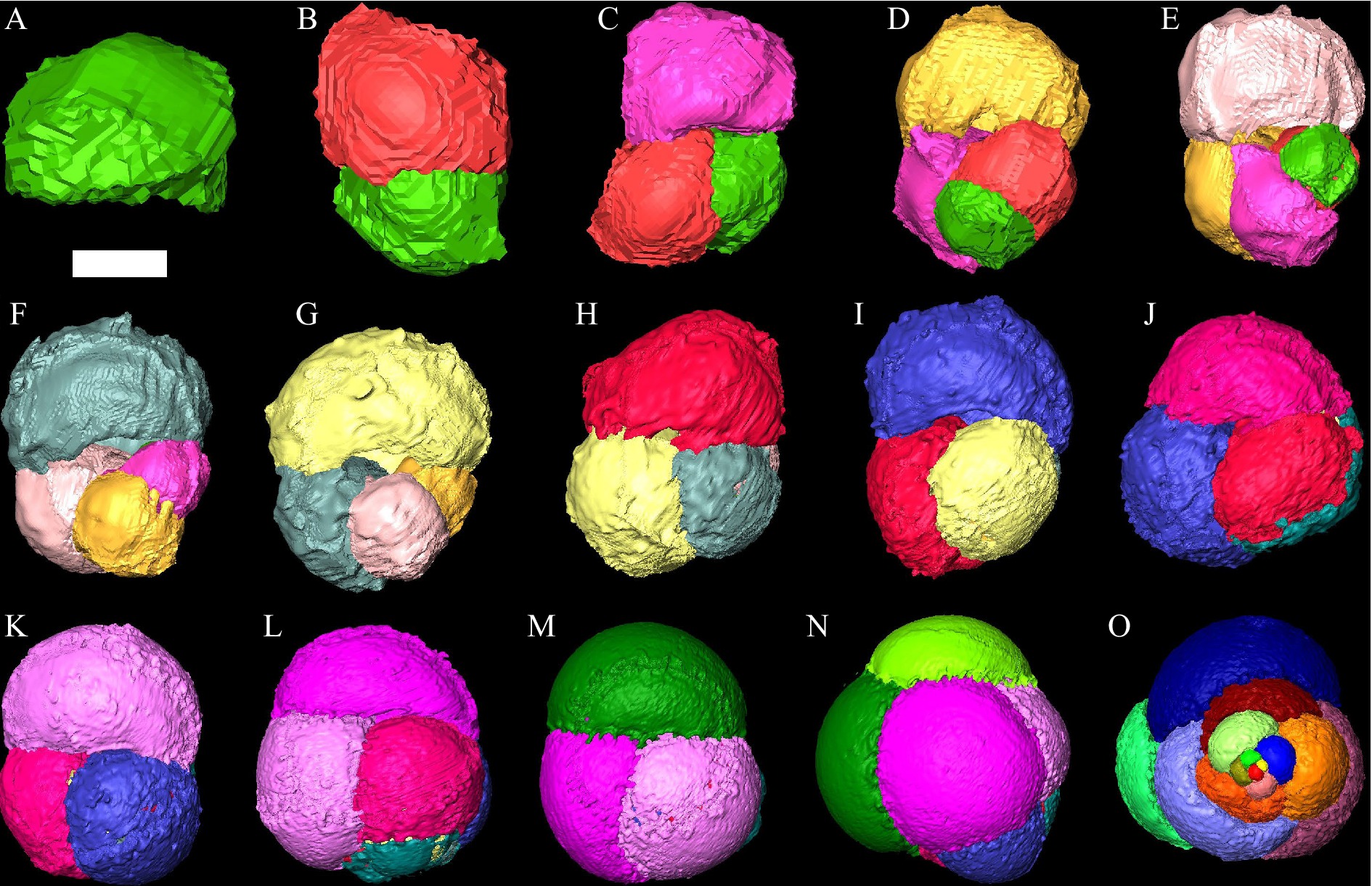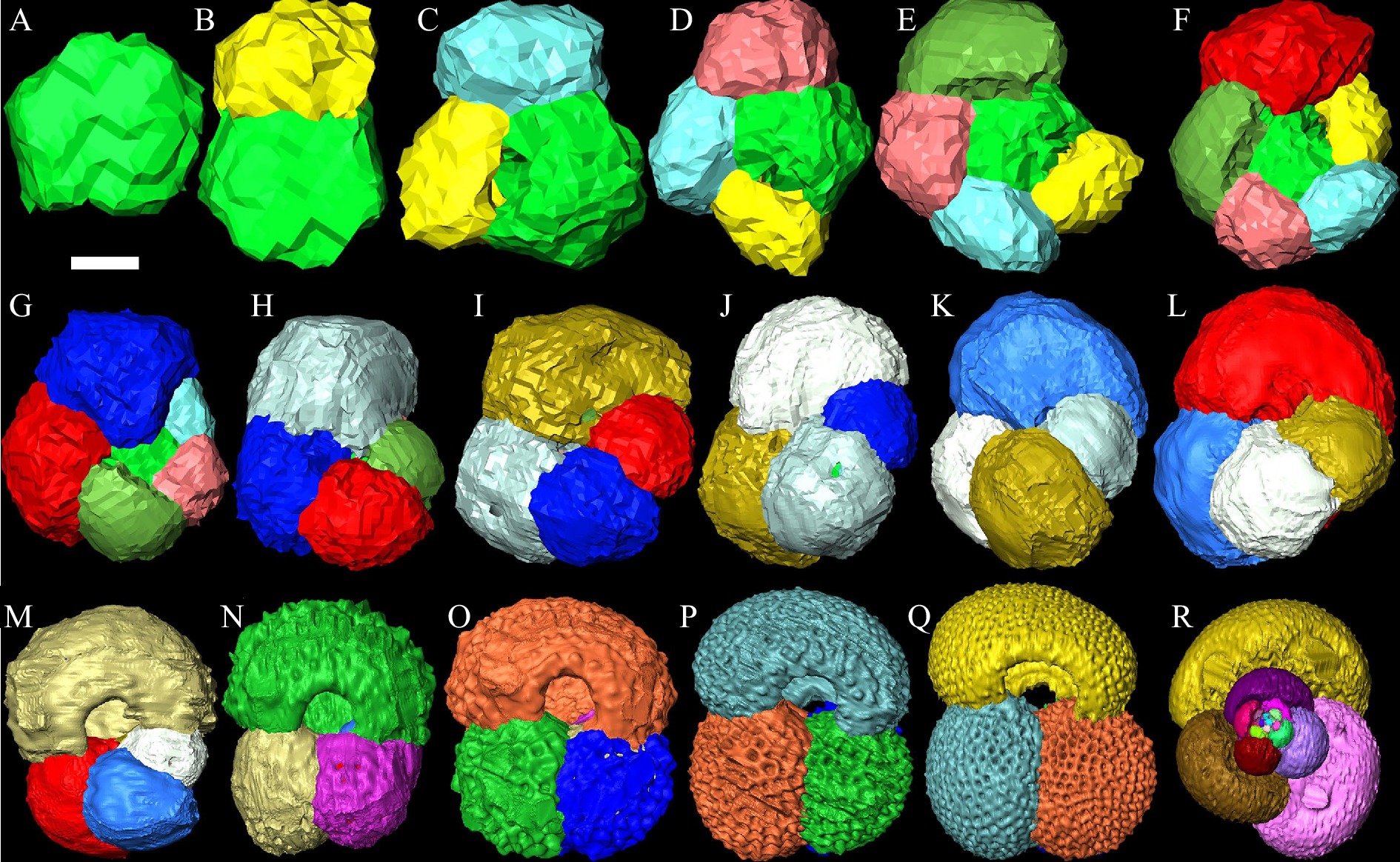Three-dimensional reconstruction of ontogeny of planktonic foraminifera in tropical West Pacific sediments and its ecological and paleoceanographic implications
-
摘要:
浮游有孔虫钙质骨骼的生物学功能及其作用机制尚不完全清楚,之前的研究认为壳体通过提供负浮力在调节浮游有孔虫的受力平衡中起作用。然而,很少有研究对浮游有孔虫的个体发育过程进行重建和定量分析以揭示在其生命过程中壳体的功能。本研究利用同步辐射X射线断层显微术(SRXTM)重建了来自热带西太平洋沉积物岩芯中的6个不同属种的浮游有孔虫壳体的个体发育。通过计算每个腔室形成前后的壳体和细胞质的总质量,能够确定整个个体发育过程中的平均密度变化模式。不同生态位属种的平均密度变化模式差异显著,表明浮力调节可能与生命周期中的垂直迁移有关,尤其是对于无刺浮游有孔虫属种。个体发育过程中的平均密度变化模式揭示了整个个体发育过程中浮力调节的范围,这可能是影响无刺浮游有孔虫属种垂向迁移的因素之一。此外,浮游有孔虫的形态演化可能涉及对生活水体垂直结构变化的适应。
Abstract:The biological function and mechanism of the calcareous skeletons of planktonic foraminifera are not fully understood. Previous studies have suggested that the shell plays a role in regulating the force balance of planktonic foraminifera by providing negative buoyancy. However, few studies have reconstructed and quantitatively analyzed the individual development process of planktonic foraminifera to reveal the function of the shell throughout their life cycle. We used synchrotron X-ray tomography to reconstruct the individual development of planktonic foraminiferal chambers from six different genera in sediment cores from the tropical western Pacific. By calculating the total mass of the shell and cytoplasm before and after the formation of each chamber, we were able to determine the average density variation pattern during the entire individual development process. We found significant differences in the patterns of average density among different ecological niche genera, suggesting that buoyancy regulation may be related to vertical migration during the life cycle, especially for non-spinose planktonic foraminifera genera. The density patterns also reveal the range of buoyancy regulation throughout the entire individual development process, which may be one of the factors on the vertical migration of non-spinose planktonic foraminiferal genera. Furthermore, the morphological evolution of planktonic foraminifera chambers may involve adaptation to changes in the vertical structure of the living water column.
-
Key words:
- planktic foraminifera /
- functional morphology /
- ontogeny /
- mean density /
- paleoceanography
-

-
表 1 6个研究标本的壳体数据统计
Table 1. The test data of six research specimens of Globorotalia menardii, G. tumida, G. truncatulinoides, Pulleniatina obliquiloculata, Candeina nitida, and Globigerinoides ruber. The data includes the volume (μm3) of each chamber and shell, the calculated mean density value (g/cm3), and the test dimensions (μm)
属种名 房室腔 体积/μm3 累计体积 /μm3 房室壁 体积/μm3 累计体积/μm3 densitymin /(g/cm3) densitymax / (g/cm3) 壳体大小/μm Globorotalia menardii c01 166 166 s01 377 377 38.3 c02 47 213 s02 162 539 2.09 2.23 28.9 c03 122 335 s03 236 775 2.05 2.19 36.0 c04 62 397 s04 257 1032 2.13 2.23 39.3 c05 194 592 s05 419 1451 2.09 2.21 38.9 c06 280 872 s06 544 1995 2.07 2.19 45.7 c07 414 1286 s07 976 2970 2.04 2.19 61.4 c08 586 1872 s08 1584 4554 2.05 2.21 73.7 c09 960 2831 s09 1635 6189 2.05 2.17 76.9 c10 1281 4113 s10 2724 8913 2.03 2.17 97.8 c11 2267 6380 s11 3950 12863 2.00 2.14 105.0 c12 3026 9406 s12 5076 17939 1.99 2.12 113.1 c13 4643 14050 s13 7064 25003 1.96 2.09 115.4 c14 10869 24919 s14 12170 37172 1.86 2.02 152.8 c15 16512 41431 s15 18521 55693 1.81 1.98 173.9 c16 20815 62246 s16 23276 78969 1.81 1.96 223.1 c17 38229 100475 s17 35268 114237 1.75 1.91 266.9 c18 110287 210762 s18 83977 198214 1.60 1.83 354.0 c19 187167 397929 s19 120059 318273 1.57 1.76 386.3 c20 343677 741606 s20 231420 549693 1.51 1.73 481.3 c21 714052 1455659 s21 878314 1428007 1.47 1.85 609.2 c22 995584 2451243 s22 2790535 4218541 1.63 2.08 765.0 G. tumida c01 414 414 s01 972 972 34.1 c02 179 593 s02 500 1472 2.06 2.22 52.7 c03 594 1187 s03 1272 2744 1.95 2.19 57.8 c04 1256 2443 s04 1775 4518 1.90 2.11 76.1 c05 1540 3983 s05 3044 7563 1.91 2.12 88.3 c06 3126 7109 s06 3263 10826 1.88 2.03 96.0 c07 5451 12560 s07 4788 15614 1.79 1.95 116.4 c08 6321 18881 s08 6153 21766 1.77 1.92 124.7 c09 12240 31121 s09 7897 29663 1.70 1.83 152.0 c10 25155 56276 s10 22104 51767 1.59 1.82 190.8 c11 52141 108417 s11 30346 82112 1.55 1.74 215.8 c12 111469 219886 s12 55245 137357 1.46 1.66 283.5 G. tumida c13 235483 455369 s13 172385 309742 1.40 1.69 385.5 c14 389404 844773 s14 301610 611352 1.46 1.72 515.1 c15 514510 1359283 s15 462381 1073732 1.53 1.75 556.2 c16 578820 1938103 s16 413016 1486749 1.61 1.74 655.9 c17 1140357 3078460 s17 1188047 2674796 1.56 1.80 781.4 c18 2212386 5290846 s18 1406219 4081015 1.57 1.74 932.9 c19 2578180 7869026 s19 4601611 8682626 1.58 1.90 1063.4 G. truncatulinoides c01 475 475 s01 759 759 24.0 c02 116 591 s02 263 1021 1.96 2.08 37.2 c03 308 899 s03 634 1655 1.91 2.11 46.6 c04 457 1356 s04 786 2441 1.94 2.10 55.5 c05 811 2167 s05 2855 5296 1.91 2.21 73.2 c06 1561 3727 s06 2144 7440 2.00 2.14 74.2 c07 2082 5809 s07 2906 10346 1.96 2.10 96.6 c08 4302 10111 s08 4953 15299 1.86 2.03 108.9 c09 8632 18743 s09 8935 24234 1.77 1.96 118.5 c10 14377 33120 s10 17830 42064 1.72 1.96 162.9 c11 28242 61362 s11 31657 73721 1.70 1.93 193.6 c12 64198 125560 s12 64840 138561 1.63 1.90 237.0 c13 103852 229412 s13 86609 225169 1.64 1.85 310.9 c14 188085 417497 s14 112457 337626 1.60 1.76 370.3 c15 325810 743307 s15 289320 626946 1.53 1.78 397.5 c16 727026 1470333 s16 432534 1059481 1.51 1.72 487.1 c17 1191190 2661522 s17 1715440 2774921 1.49 1.87 605.0 Pulleniatina obliquiloculata c01 996 996 s01 1379 1280 33.5 c02 739 1735 s02 937 2217 1.73 1.96 48.4 c03 1760 3495 s03 1519 3736 1.66 1.88 58.5 c04 4649 8144 s04 3417 7153 1.54 1.80 79.8 c05 13611 21754 s05 8354 15507 1.42 1.71 109.9 c06 38918 60673 s06 18227 33733 1.35 1.61 150.5 c07 92030 152703 s07 36149 69883 1.31 1.54 200.8 c08 195731 348434 s08 80291 150173 1.29 1.52 247.4 c09 415248 763682 s09 93320 243493 1.28 1.41 312.1 c10 854894 1618576 s10 174114 417607 1.22 1.35 376.4 c11 1392006 3010582 s11 366395 784002 1.21 1.35 459.2 c12 2900732 5911314 s12 701697 1485698 1.20 1.34 527.6 c13 4055033 9966347 s13 4283791 5769489 1.22 1.63 712.5 Candeina nitida c01 645 645 s01 794 794 31.9 c02 1278 1923 s02 1014 1809 1.50 1.83 50.6 c03 2292 4215 s03 1917 3726 1.51 1.80 63.1 c04 5461 9676 s04 3160 6885 1.48 1.71 81.6 c05 11501 21177 s05 6096 12981 1.42 1.65 102.9 c06 31140 52317 s06 12986 25967 1.34 1.57 130.5 c07 97271 149588 s07 29926 55893 1.25 1.47 175.6 c08 132344 281932 s08 48221 104115 1.28 1.46 223.2 c09 317086 599018 s09 91918 196033 1.25 1.42 279.6 c10 287951 886969 s10 75696 271729 1.31 1.40 298.8 c11 778892 1665862 s11 159270 430998 1.24 1.35 371.4 c12 834837 2500698 s12 190084 621082 1.25 1.34 412.3 c13 1292146 3792844 s13 228612 849694 1.24 1.31 454.7 c14 587528 4380372 s14 114253 963947 1.28 1.31 501.2 Globigerinoides ruber c01 699 699 s01 1632 1632 17.6 c02 395 1094 s02 1028 2661 2.02 2.21 23.1 c03 448 1542 s03 1189 3849 2.08 2.22 25.4 c04 778 2320 s04 1358 5207 2.07 2.18 35.0 c05 1162 3482 s05 2072 7279 2.02 2.16 36.7 c06 3043 6525 s06 3427 10706 1.90 2.06 43.1 c07 3579 10104 s07 5475 16181 1.88 2.05 48.0 c08 7621 17725 s08 11517 27698 1.82 2.04 60.6 c09 20766 38491 s09 16012 43709 1.72 1.91 67.2 c10 23090 61582 s10 17609 61318 1.71 1.85 76.4 c11 49052 110634 s11 47082 108400 1.61 1.85 92.8 c12 120446 231080 s12 71660 180060 1.55 1.75 116.9 c13 310757 541837 s13 410887 590947 1.43 1.89 146.3 c14 592439 1134276 s14 1243357 1834304 1.59 2.06 220.8 c15 1488848 2623124 s15 1626995 3461299 1.70 1.97 268.9 c16 2707299 5330423 s16 2311167 5772466 1.67 1.89 328.2 c17 6108941 11439364 s17 2240540 8013006 1.57 1.70 393.3 -
[1] Marszalek D S. The role of heavy skeletons in vertical movements of non-motile zooplankton[J]. Marine Behaviour and Physiology, 1982, 8(4): 295-303. doi: 10.1080/10236248209387026
[2] Raven J A, Waite A M. The evolution of silicification in diatoms: inescapable sinking and sinking as escape?[J]. New Phytologist, 2004, 162(1): 45-61. doi: 10.1111/j.1469-8137.2004.01022.x
[3] Aze T, Ezard T H G, Purvis A, et al. A phylogeny of Cenozoic macroperforate planktonic foraminifera from fossil data[J]. Biological Reviews, 2011, 86(4): 900-927. doi: 10.1111/j.1469-185X.2011.00178.x
[4] Hemleben C, Spindler M, Anderson O R. Modern Planktonic Foraminifera[M]. New York: Springer-Verlag, 1989.
[5] Rebotim A, Voelker A H L, Jonkers L, et al. Factors controlling the depth habitat of planktonic foraminifera in the subtropical eastern North Atlantic[J]. Biogeosciences, 2017, 14(4): 827-859. doi: 10.5194/bg-14-827-2017
[6] Huisman J, Arrayás M, Ebert U, et al. How do sinking phytoplankton species manage to persist?[J]. The American Naturalist, 2002, 159(3): 245-254. doi: 10.1086/338511
[7] Kahn N, Swift E. Positive buoyancy through ionic control in the nonmotile marine dinoflagellate Pyrocystis noctiluca Murray ex Schuett[J]. Limnology and Oceanography, 1978, 23(4): 649-658. doi: 10.4319/lo.1978.23.4.0649
[8] Walsby A E, Hayes P K, Boje R et al. The selective advantage of buoyancy provided by gas vesicles for planktonic cyanobacteria in the Baltic Sea[J]. New Phytologist, 1997, 136(3): 407-417. doi: 10.1046/j.1469-8137.1997.00754.x
[9] Smayda T J. The suspension and sinking of phytoplankton in the sea[J]. Oceanography and Marine Biology, 1970, 8: 353-414.
[10] Berger W H. Planktonic foraminifera: basic morphology and ecologic implications[J]. Journal of Paleontology, 1969, 43(6): 1369-1383.
[11] Tyszka J. Morphospace of foraminiferal shells: results from the moving reference model[J]. Lethaia, 2006, 39(1): 1-12. doi: 10.1080/00241160600575808
[12] Caromel A G M, Schmidt D N, Rayfield E J. Ontogenetic constraints on foraminiferal test construction[J]. Evolution & Development, 2017, 19(3): 157-168.
[13] Caromel A G M, Schmidt D N, Phillips J C, et al. Hydrodynamic constraints on the evolution and ecology of planktic foraminifera[J]. Marine Micropaleontology, 2014, 106: 69-78. doi: 10.1016/j.marmicro.2014.01.002
[14] Hsiang A Y, Elder L E, Hull P M. Towards a morphological metric of assemblage dynamics in the fossil record: a test case using planktonic foraminifera[J]. Philosophical Transactions of the Royal Society B: Biological Sciences, 2016, 371(1691): 20150227. doi: 10.1098/rstb.2015.0227
[15] Lipps J H. Ecology and paleoecology of planktic foraminifera[M]//Lipps J H, Berger W H, Buzas M A, et al. Foraminiferal Ecology and Paleoecology. Tulsa: SEPM Society for Sedimentary Geology, 1979: 62-104.
[16] Bé A W H, Jongebloed W L, McIntyre A. X-ray microscopy of recent planktonic foraminifera[J]. Journal of Paleontology, 1969, 43(6): 1384-1396.
[17] Brummer G J A, Hemleben C, Spindler M. Planktonic foraminiferal ontogeny and new perspectives for micropalaeontology[J]. Nature, 1986, 319(6048): 50-52. doi: 10.1038/319050a0
[18] Brummer G J A, Hemleben C, Spindler M. Ontogeny of extant spinose planktonic foraminifera (Globigerinidae): a concept exemplified by Globigerinoides sacculifer (Brady) and G. ruber (d'Orbigny)[J]. Marine Micropaleontology, 1987, 12: 357-381. doi: 10.1016/0377-8398(87)90028-4
[19] Sverdlove M S, Bé A W H. Taxonomic and ecological significance of embryonic and juvenile planktonic foraminifera[J]. Journal of Foraminiferal Research, 1985, 15(4): 235-241. doi: 10.2113/gsjfr.15.4.235
[20] Huber B T. Ontogenetic morphometrics of some Late Cretaceous trochospiral planktonic foraminifera from the austral realm[J]. Smithsonian Contributions to Paleobiology, 1994, 77: 1-85.
[21] Donoghue P C J, Bengtson S, Dong X P, et al. Synchrotron X-ray tomographic microscopy of fossil embryos[J]. Nature, 2006, 442(7103): 680-683. doi: 10.1038/nature04890
[22] Speijer R P, Van Loo D, Masschaele B, et al. Quantifying foraminiferal growth with high-resolution X-ray computed tomography: new opportunities in foraminiferal ontogeny, phylogeny, and paleoceanographic applications[J]. Geosphere, 2008, 4(4): 760-763. doi: 10.1130/GES00176.1
[23] Briguglio A, Benedetti A. X-ray microtomography as a tool to present and discuss new taxa: the example of Risananeiza sp. from the late Chattian of Porto Badisco[J]. Rendiconti Online Societa Geologica Italiana, 2012, 21: 1072-1074.
[24] Hohenegger J, Briguglio A. Axially oriented sections of Nummulitids: a tool to interpret larger benthic foraminiferal deposits[J]. Journal of Foraminiferal Research, 2012, 42(2): 134-142. doi: 10.2113/gsjfr.42.2.134
[25] Briguglio A, Hohenegger J. Growth oscillation in larger foraminifera[J]. Paleobiology, 2014, 40(3): 494-509. doi: 10.1666/13051
[26] Schmidt D N, Rayfield E J, Cocking A, et al. Linking evolution and development: synchrotron radiation X-ray tomographic microscopy of planktic foraminifers[J]. Palaeontology, 2013, 56(4): 741-749. doi: 10.1111/pala.12013
[27] Caromel A G M, Schmidt D N, Fletcher I, et al. Morphological change during the ontogeny of the planktic foraminifera[J]. Journal of Micropalaeontology, 2016, 35(1): 2-19.
[28] Korsun S, Hald M, Panteleeva N, et al. Biomass of foraminifera in the St. Anna Trough, Russian arctic continental margin[J]. Sarsia, 1998, 83(5): 419-431. doi: 10.1080/00364827.1998.10413701
[29] Bé A W H, Tolderlund D S. Distribution and ecology of living planktonic foraminifera in surface waters of the Atlantic and Indian Oceans[M]//Funnell B M, Riedel W K. The Micropaleontology of the Oceans. Cambridge: Cambridge University Press, 1971: 105-149.
[30] Fok-Pun L, Komar P D. Settling velocities of planktonic foraminifera: density variations and shape effects[J]. Journal of Foraminiferal Research, 1983, 13(1): 60-68. doi: 10.2113/gsjfr.13.1.60
[31] Oehmig R. Entrainment of planktonic foraminifera: effect of bulk density[J]. Sedimentology, 1993, 40(5): 869-877. doi: 10.1111/j.1365-3091.1993.tb01366.x
[32] Schiebel R, Hemleben C. Planktic Foraminifers in the Modern Ocean[M]. Berlin Heidelberg: Springer, 2017.
[33] Bijma J, Faber W W Jr, Hemleben C. Temperature and salinity limits for growth and survival of some planktonic foraminifers in laboratory cultures[J]. Journal of Foraminiferal Research, 1990, 20(2): 95-116. doi: 10.2113/gsjfr.20.2.95
[34] Schiebel R, Bijma J, Hemleben C. Population dynamics of the planktic foraminifer Globigerina bulloides from the eastern North Atlantic[J]. Deep Sea Research Part I: Oceanographic Research Papers, 1997, 44(9-10): 1701-1713. doi: 10.1016/S0967-0637(97)00036-8
[35] Schmidt D N, Renaud S, Bollmann J. Response of planktic foraminiferal size to late Quaternary climate change[J]. Paleoceanography, 2003, 18(3): 1039.
[36] Hecht A D, Savin S M. Phenotypic variation and oxygen isotope ratios in Recent planktonic foraminifera[J]. Journal of Foraminiferal Research, 1972, 2(2): 55-67. doi: 10.2113/gsjfr.2.2.55
[37] Hecht A D. Intraspecific variation in recent populations of Globigerinoides ruber and Globigerinoides trilobus and their application to paleoenvironmental analysis[J]. Journal of Paleontology, 1974, 48(6): 1217-1234.
[38] Renaud S, Schmidt D N. Habitat tracking as a response of the planktic foraminifer Globorotalia truncatulinoides to environmental fluctuations during the last 140 kyr[J]. Marine Micropaleontology, 2003, 49(1-2): 97-122. doi: 10.1016/S0377-8398(03)00031-8
[39] Schmidt D N, Renaud S, Bollmann J, et al. Size distribution of Holocene planktic foraminifer assemblages: biogeography, ecology and adaptation[J]. Marine Micropaleontology, 2004, 50(3-4): 319-338. doi: 10.1016/S0377-8398(03)00098-7
-



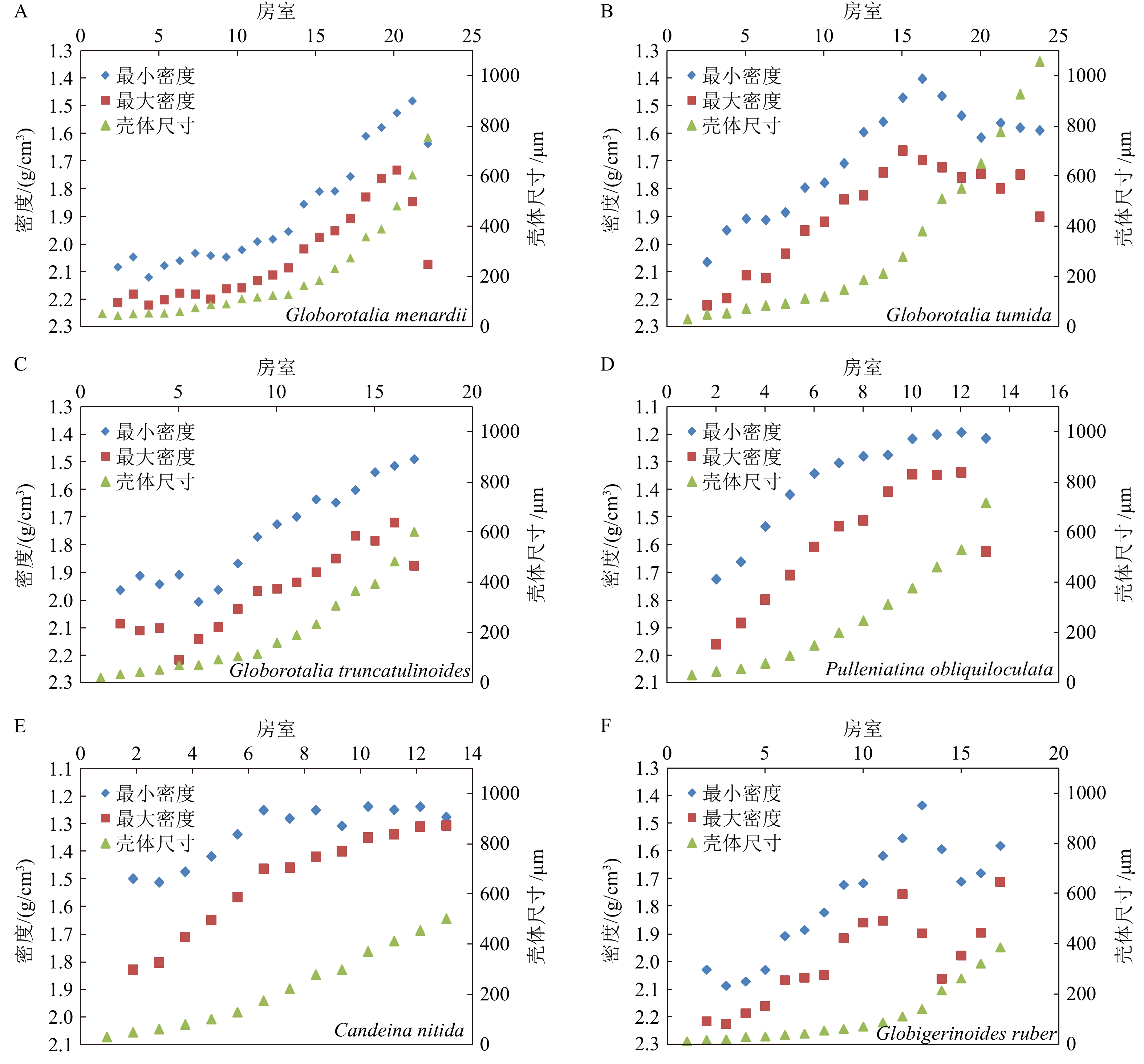
 下载:
下载:
